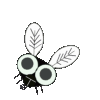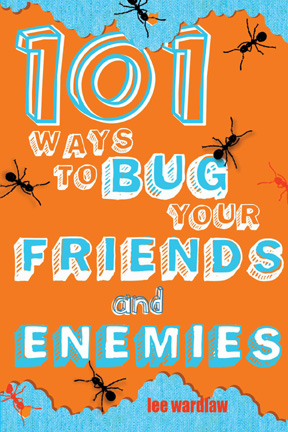Now available...
The Sequel to the Award-winning Novels
101 Ways to Bug Your Parents
and
101 Ways to Bug Your Teacher…
 |

101 Ways to Bug
Your Friends and Enemies
A novel by Lee Wardlaw
Dial Books for Young Readers (hardcover)
Puffin (softcover)
Ages 10-14
2012 National Forward Literature Award - Humor
2012 California Readers - A California Collections Book
2012 SBCEO and LUSC Battle of the Books
For a Teacher's Guide, click here
To read a funny interview with Lee Wardlaw about the novel, click here
|
Now there are 303 reasons to fall for Sneeze, Hiccup, Hayley,
and the rest of the Gadabout gang!
|
Number 36: Repeat everything they say.
Number 37: Repeat everything they say.
Stephen “Sneeze” Wyatt has more on his plate than any eighth grader should—even one who’s a genius inventor taking high school classes:
- a meathead varsity golf goon has it in for him
- his friends are acting funny (not funny ha-ha; funny weird)
- his crush is drooling over that handsome new Hawaiian kid
- he finds himself writing…love-letters (what?!)
- his Nice Alarm is not working nicely
- and he still can’t get out of taking PE.
With an hilarious cast, plenty of zingy banter, and a plot that features a Cyrano de Bergerac twist, this third book in the 101 Ways series delivers the goods – for friends and enemies, alike!
School Library Journal: "...with a unique cast of characters (including supportive parents) and plenty of conflict and humor,
this is a good choice for reluctant readers, including those who haven’t read the first two books."
Kirkus: "...a humorous presentation...of young teens exploring unrequited love...."
The BK Club: "As with 101 Ways to Bug Your Parents and 101 Ways to Bug your Teacher, Wardlaw relates to preteen’s struggles using humor and understanding..." |
Interview with Author Lee Wardlaw
by Tracie Vaughn Zimmer
| Q |
How easy was it to find yourself back to the Gadabout World?
|
| A |
Writing is not easy. It’s W.O.R.K. But, I love the characters in this series, so getting the chance to spend time with them again made the work easy-ish. After the first few scenes, I slipped right back into their mindsets and voices, and felt take-off-your-shoes-and-hang-out comfy around them – just like you do when you’re reunited with a friend whom you haven’t seen in a long time.
This doesn’t mean I didn’t feel awkward around Sneeze, Hayley and Hiccup. I did – at first. Three months pass between where 101 Ways to Bug Your Teacher ends and 101 Ways to Bug Your Friends and Enemies begins. Three months doesn’t sound long, but middle schoolers can go through huge physical and psychological changes over the course of one summer break. They become a tangle of arms and legs and emotions that’s dramatic, confusing and frustrating. Come September, they often don’t recognize their friends – or themselves! So in order to recognize my characters and portray them authentically, empathetically, I had to time travel back to my own adolescence and remember what those days felt like. Remembering was a snap. Reliving it? Not so easy. In fact, at times it was downright painful!
Fortunately, whenever I got stuck for how a character might act or feel in a given situation, all I had to do was spend time with my son and his friends (who are now 15) – and their behavior would give me the answer!
|
| Q |
Who is your favorite character to write in this series?
|
| A |
This is like asking the parents of five children: “Which
child is your favorite?” It’s a question I can’t answer, because each character is like a child – my child – to me; and I adore each one for the individual he or she is. I love plowing through my dog-eared copy of Merck’s Manual to come up with exotic disorders to satisfy Hiccup’s hypochondria. Writing dialogue for Pierre – who speeks wis zee phonee French accent –is silly and fun – and if you can’t have fun when you’re writing, why bother? Hayley has a confidence I never had at her age (maybe not even now!), so I admire her tremendously for that and the ability to speak her mind. And Sneeze…well, Sneeze has passion and perseverance and principles – not to mention all those outrageous inventions! He’s also funny – and I love funny. Sneeze is probably the most like me of any of my characters, so I can’t help but enjoy spending time with him.
|
| Q |
Why did you model parts of your novel after the play Cyrano de Bergerac?
|
| A |
Edmond Rostand’s play features themes that
adolescents can easily relate to: first love, unrequited
love, the mistaken belief that one is undeserving of love, fear of risk and rejection, outer vs. inner beauty, the conflict between who you are and who you want to be, friendship, loyalty, the joy of living and living with joy – and principles. It’s also filled with brilliant word-play and a heroic main character. I firmly believe adolescents need to be exposed to more of the true heroes in literature.
|
| Q |
What is the best piece of writing advice you’ve ever received?
|
| A |
This quote from the book Art and Fear, by David Bayles and Ted Orland, says it all: “…becoming an artist consists of learning to accept yourself, which makes your work personal, and in following your own voice, which makes your work distinctive.” |
| Q |
What can your fans look forward to next?
|
| A |
Isn’t it obvious? I must write 101 Ways to Bug Your Brother and Sister! I never had a sister, but I have two younger brothers whom I adore now, but as a kid they used to drive me crazy because they were overly fond
of ripping the heads off my Barbie dolls and holding them for ransom! |
|







